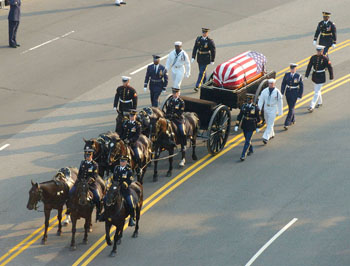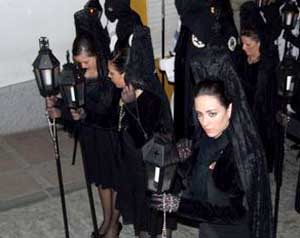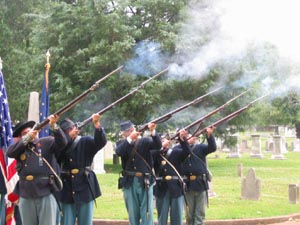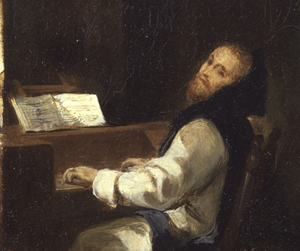 |
Formation of Children
Catholic Funeral Etiquette - Part II
Courtesies Paid to the Family of the Deceased
Marian T. Horvat, Ph.D.
One should set aside his other affairs in order to pay a friend his last respects. It is proper to write a letter of condolence to the family of the deceased. Today, one can purchase cards with poems and pretty sentiments, but the more appropriate letter is handwritten on white personal paper. The letters should be brief, dignified and sympathetic. The tone varies with the degree of acquaintance with the family of the deceased.

At the funeral of President Reagan, the nation paid its last homage |
Your services or assistance can also be offered in the difficult time of mourning. If you are close to the family, a concrete suggestion, such as an offer to run errands, provide a meal, or pick up relatives at the airport, is better than a vague proposal, and more likely to be accepted. A small assistance can be an invaluable aid in these often hectic days, a gesture that will not be forgotten.
Since the noblest of all prayer is the Holy Sacrifice of the Mass, the greatest kindness one can offer to the departed relative or friend is to have a Mass offered for the eternal repose of his soul.
The sending of flowers is also a kind and courteous gesture. Influenced by a Protestant mentality, some Catholics announce they want no flowers, that they are a waste of money. This is not true. Their beauty, fragrance and color are a Catholic last homage to a lost friend that reflects the noble sentiments of our esteem and gratitude. Indeed, noble sentiments often have fugacious expressions.
Think about a man who saves a city in a heroic effort; a youth who dies for his country in a hard battle; a young lady who professes her solemn vows and enters the religious life; a man who dying speaks his last wishes. All these sentiments are expressed in just one moment - a fleeting expression - but they last forever. Hence, pay no heed to the Calvinist suggestion to save money in flowers. Make a generous expression of your love for and gratitude to your dead friend. Send him flowers as your last homage.
One who assists at a funeral Mass should be recollected at this ceremony. He should discreetly show the grieving family all the compassion possible. The small talk at the church or burial site should also be tactful and serious. It can be difficult to find the appropriate words to say at that time. On such occasion, one may express the sentiment of loss, attenuated by Christian hope: “Please accept my sympathy for the death of your father. I had the honor to be his friend for many years, and it is a great loss for me also. Be sure of my prayers for his soul.”
The funeral
It is customary to express one’s sorrow by wearing the color black at funerals. This is a good custom that should be maintained, because the color black became the traditional sign of mourning and expression of grief in Western culture.

Spanish women wearing traditional mantillas accompany a funeral procession to the Church |
Even if he is not a member of the immediate family, a man should wear a dark suit, black tie, white shirt and black shoes to the funeral Mass. A woman should dress in black, or at least in dark or neutral tones. Jewelry should be discrete or absent. Widows, mothers and daughters of the deceased person used to wear mourning veils to the funeral. It was not a penance but an accommodation, a resource to protect them from curious glances in a time of distress. In Spain, the bereaved ladies still wear ‘la mantilla,’ an elegant black veil fastened by a beautiful comb as they follow the funeral train to the Mass.
In some places, the strange custom of wearing dark sunglasses was introduced for funerals. I can understand their use in the case of a lady who has been weeping so much that her eyes are disfigured and she wants to conceal them. Even in this situation, sunglasses should be worn only outdoors at the cemetery or in the car traveling to it, never inside the church. It is, in my opinion, a senseless and modern extravagance to wear sunglasses inside the church at a funeral Mass.
The traditional funeral garb for young children of the deceased family is all-white outfits. Today, however, mourning wear for children under age 14 is not considered necessary.
Unfortunately, this respected custom of wearing black to funerals is being abandoned because people do not want to consider death with the seriousness it has. Many so-called Catholics, who no longer believe in the existence of Purgatory and Hell, prefer to blithely assume their relatives are in Heaven, and therefore that the funeral is an occasion of celebration. Others have adopted the pagan and pantheistic error that the spirit of the deceased will reincarnate in some other body in the universe, so there is no need for prayer or mourning.

Protestant style: Michael Jackson sings, laughs and claps at the funeral of his friend James Brown |
Another novel custom being adopted at Catholic funerals is the practice of public eulogies at the funeral Mass. In these sentimental displays, family members and friends are invited to the “podium” to praise the deceased, tell short anecdotes, and so on. Yet others, following the American custom of constant joking and making light of even the most sacred and serious occasion, intersperse their eulogies with funny stories.
This flouts the Catholic custom of a solemn funeral sermon delivered by the priest, reminding all of the seriousness of death and the importance of praying for the soul of the deceased. The priest also may take the opportunity to praise the Catholic customs and devotion of the deceased, or offer some public words of consolation to the remaining family members, but without extravagance or excessive emotion. The custom of making public eulogies at the funerals is not Catholic, but a practice Progressivism took from the Protestant “funeral service.”

A three-volley salute at a military funeral |
If the deceased was a public figure, other public figures or prominent friends may deliver a short speech at the cemetery before the priest says the last prayers delivering the body to the earth until the final resurrection. If the deceased was a military man, before the coffin is lowered, funeral honors are paid by a special guard. "Taps" is played on the bugle, and a three-volley salute is fired for most branches of the military. For the Navy, a cannon will be fired, a practice which originated in the British Royal Navy. The flag that covered the casket is folded and is then presented to next-of-kin.
The funeral service should take place in accordance with the wishes of the deceased, manifested in a written will or some confidential words. If he left no instructions, everything should be done in accordance with tradition and his social level.
It should not be necessary to say that Catholics faithful to tradition are not cremated. Cremation, which was advocated by enemies of the Church with the express purpose of destroying belief in the immortality of the soul and the final resurrection of the body, was always forbidden by the Church. In 1963, Paul VI revoked the canon forbidding cremation, an innovation generally considered to be a concession made to Freemasonry.
The exemplary death of Charles V

Emperor Charles V became a monk in the Monastery of Yuste - Eugene Delacroix |
At the peak of his fame in the year 1556, Charles V, Holy Roman Emperor, King of Spain and of the Spanish possessions in America, King of Germany, the Netherlands, Naples, and Sicily, abdicated from power. He retired to the Monastery of Yuste in Extremadura, Spain, in 1557 to prepare for his approaching death. Although messengers with political despatches came to him every day, he took no active part in affairs.
The last six months of his life, his physical health deteriorated greatly. During this period he removed himself completely from all affairs of state, conforming to all the rigor of monastic austerity. He desired no other society than that of the monks, and chanted with them the Hours of the Divine Office. To expiate for his sins, he took the discipline. Thus he lived his remaining months on earth stripped of his earthly titles and preparing himself to bien morir [die well] and the life to come. He died there on September 24, 1558.
St. Ignatius of Loyola had this to say about the King’s last days: “The Emperor gave a rare example to his successors ... In so doing, he proved himself to be a true Catholic prince. May the Lord in all His goodness now grant the Emperor freedom."
Continued

Posted July 24, 2008

Related Topics of Interest
 Funeral Etiquette - Part I Funeral Etiquette - Part I
 Requiescant in Pace... Requiescant in Pace...
 The Blessing - Manual of Civility The Blessing - Manual of Civility
 Something Fishy about the Death of John Paul II Something Fishy about the Death of John Paul II
 The Novissima - the Four Last Things The Novissima - the Four Last Things
 Americans Think Hell Exists, But No One Goes There Americans Think Hell Exists, But No One Goes There
 Importance of the Devotion to St. Joseph Importance of the Devotion to St. Joseph
 A Black-out on Black A Black-out on Black

Related Works of Interest
|
|
Formation | Cultural | Home | Books | CDs | Search | Contact Us | Donate

© 2002- Tradition in Action, Inc. All Rights Reserved
|
 |
|